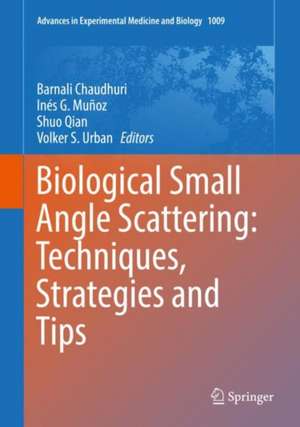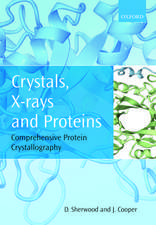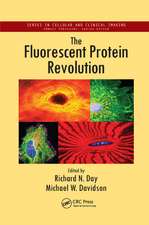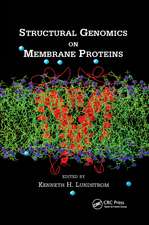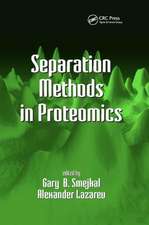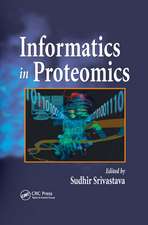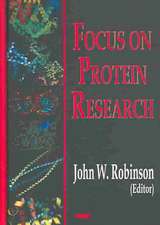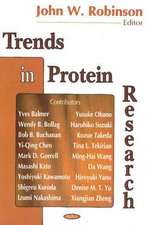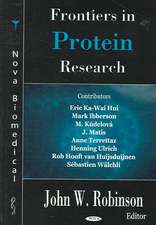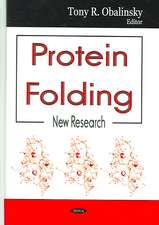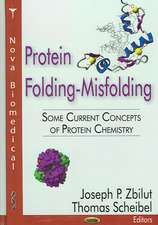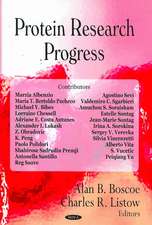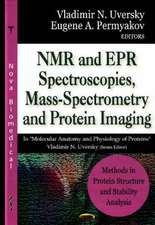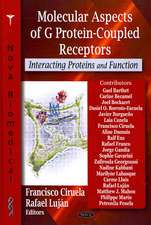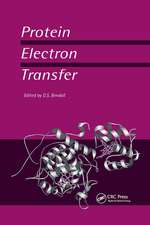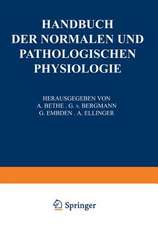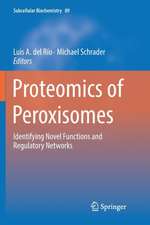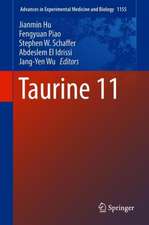Biological Small Angle Scattering: Techniques, Strategies and Tips: Advances in Experimental Medicine and Biology, cartea 1009
Editat de Barnali Chaudhuri, Inés G. Muñoz, Shuo Qian, Volker S. Urbanen Limba Engleză Hardback – 29 dec 2017
The scope of this book is particularly relevant for structural biology researchers who are new to SAS. Advanced users of the technique will findit helpful for exploring the diversity of solution SAS methods and applications.
Chapter 3 of this book is available open access under a CC BY 4.0 license at link.springer.com.
| Toate formatele și edițiile | Preț | Express |
|---|---|---|
| Paperback (1) | 838.47 lei 38-44 zile | |
| Springer Nature Singapore – 11 dec 2018 | 838.47 lei 38-44 zile | |
| Hardback (1) | 855.55 lei 38-44 zile | |
| Springer Nature Singapore – 29 dec 2017 | 855.55 lei 38-44 zile |
Din seria Advances in Experimental Medicine and Biology
- 9%
 Preț: 719.56 lei
Preț: 719.56 lei - 5%
 Preț: 1095.03 lei
Preț: 1095.03 lei - 20%
 Preț: 691.93 lei
Preț: 691.93 lei - 5%
 Preț: 704.94 lei
Preț: 704.94 lei - 5%
 Preț: 704.94 lei
Preț: 704.94 lei - 5%
 Preț: 703.32 lei
Preț: 703.32 lei - 5%
 Preț: 704.22 lei
Preț: 704.22 lei - 5%
 Preț: 239.86 lei
Preț: 239.86 lei -
 Preț: 642.95 lei
Preț: 642.95 lei - 5%
 Preț: 820.42 lei
Preț: 820.42 lei - 5%
 Preț: 703.67 lei
Preț: 703.67 lei - 15%
 Preț: 629.45 lei
Preț: 629.45 lei - 15%
 Preț: 630.60 lei
Preț: 630.60 lei - 5%
 Preț: 1013.60 lei
Preț: 1013.60 lei - 5%
 Preț: 704.22 lei
Preț: 704.22 lei - 5%
 Preț: 705.14 lei
Preț: 705.14 lei - 20%
 Preț: 1142.10 lei
Preț: 1142.10 lei - 5%
 Preț: 1150.76 lei
Preț: 1150.76 lei - 18%
 Preț: 1100.97 lei
Preț: 1100.97 lei - 5%
 Preț: 1266.72 lei
Preț: 1266.72 lei - 5%
 Preț: 1145.01 lei
Preț: 1145.01 lei - 5%
 Preț: 1083.16 lei
Preț: 1083.16 lei - 18%
 Preț: 1104.69 lei
Preț: 1104.69 lei - 5%
 Preț: 1411.39 lei
Preț: 1411.39 lei - 20%
 Preț: 1026.46 lei
Preț: 1026.46 lei - 18%
 Preț: 930.42 lei
Preț: 930.42 lei - 5%
 Preț: 292.57 lei
Preț: 292.57 lei - 18%
 Preț: 941.47 lei
Preț: 941.47 lei - 18%
 Preț: 1214.88 lei
Preț: 1214.88 lei - 5%
 Preț: 1210.77 lei
Preț: 1210.77 lei - 5%
 Preț: 1270.49 lei
Preț: 1270.49 lei - 5%
 Preț: 1083.51 lei
Preț: 1083.51 lei - 18%
 Preț: 1113.70 lei
Preț: 1113.70 lei - 5%
 Preț: 1145.52 lei
Preț: 1145.52 lei - 5%
 Preț: 1394.53 lei
Preț: 1394.53 lei - 5%
 Preț: 1283.60 lei
Preț: 1283.60 lei - 18%
 Preț: 1393.77 lei
Preț: 1393.77 lei - 18%
 Preț: 1389.12 lei
Preț: 1389.12 lei - 24%
 Preț: 806.15 lei
Preț: 806.15 lei - 18%
 Preț: 1222.29 lei
Preț: 1222.29 lei - 5%
 Preț: 1405.29 lei
Preț: 1405.29 lei - 5%
 Preț: 1591.34 lei
Preț: 1591.34 lei - 5%
 Preț: 1283.09 lei
Preț: 1283.09 lei - 18%
 Preț: 1105.93 lei
Preț: 1105.93 lei - 5%
 Preț: 1079.03 lei
Preț: 1079.03 lei - 15%
 Preț: 638.91 lei
Preț: 638.91 lei - 5%
 Preț: 1079.03 lei
Preț: 1079.03 lei - 18%
 Preț: 929.84 lei
Preț: 929.84 lei
Preț: 855.55 lei
Preț vechi: 1125.73 lei
-24% Nou
Puncte Express: 1283
Preț estimativ în valută:
163.78€ • 168.44$ • 135.88£
163.78€ • 168.44$ • 135.88£
Carte tipărită la comandă
Livrare economică 12-18 februarie
Preluare comenzi: 021 569.72.76
Specificații
ISBN-13: 9789811060373
ISBN-10: 9811060371
Pagini: 268
Ilustrații: X, 268 p. 87 illus., 77 illus. in color.
Dimensiuni: 178 x 254 x 18 mm
Greutate: 0.77 kg
Ediția:1st ed. 2017
Editura: Springer Nature Singapore
Colecția Springer
Seria Advances in Experimental Medicine and Biology
Locul publicării:Singapore, Singapore
ISBN-10: 9811060371
Pagini: 268
Ilustrații: X, 268 p. 87 illus., 77 illus. in color.
Dimensiuni: 178 x 254 x 18 mm
Greutate: 0.77 kg
Ediția:1st ed. 2017
Editura: Springer Nature Singapore
Colecția Springer
Seria Advances in Experimental Medicine and Biology
Locul publicării:Singapore, Singapore
Cuprins
Sample and Buffer preparation for SAXS.- Considerations for sample preparation using size-exclusion chromatography.- How to analyze and present SAS data for publication.- Designing and Performing Biological Solution Small-Angle Neutron Scattering Contrast Variation Experiments on Multi-component Assemblies.- SAS-based structural modeling and model validation.- Structural Characterization of Highly Flexible Proteins by Small-Angle Scattering.- What can we learn from wide-angle solution scattering?.- SAS-based studies of protein fibrillation.- High Resolution Distance Distributions Determined by X-ray and Neutron Scattering.- A successful combination: coupling SE-HPLC with SAXS.- Applications of SANS to study membrane protein systems.- Hybrid applications of solution scattering to aid structural biology.- A practical guide to iSPOT modeling: An integrative structural biology platform.- Small angle scattering for pharmaceutical applications: From drugs to drug delivery system.
Textul de pe ultima copertă
This book provides a clear, comprehensible and up-to-date description of how Small Angle Scattering (SAS) can help structural biology researchers. SAS is an efficient technique that offers structural information on how biological macromolecules behave in solution. SAS provides distinct and complementary data for integrative structural biology approaches in combination with other widely used probes, such as X-ray crystallography, Nuclear magnetic resonance, Mass spectrometry and Cryo-electron Microscopy. The development of brilliant synchrotron small-angle X-ray scattering (SAXS) beam lines has increased the number of researchers interested in solution scattering. SAS is especially useful for studying conformational changes in proteins, highly flexible proteins, and intrinsically disordered proteins. Small-angle neutron scattering (SANS) with neutron contrast variation is ideally suited for studying multi-component assemblies as well as membrane proteins that are stabilized in surfactant micelles or vesicles. SAS is also used for studying dynamic processes of protein fibrillation in amyloid diseases, and pharmaceutical drug delivery. The combination with size-exclusion chromatography further increases the range of SAS applications.
The book is written by leading experts in solution SAS methodologies. The principles and theoretical background of various SAS techniques are included, along with practical aspects that range from sample preparation to data presentation for publication. Topics covered include techniques for improving data quality and analysis, as well as different scientific applications of SAS. With abundant illustrations and practical tips, we hope the clear explanations of the principles and the reviews on the latest progresses will serve as a guide through all aspects of biological solution SAS.
The scope of this book is particularly relevant for structural biology researchers who are new to SAS. Advanced users of the technique willfind it helpful for exploring the diversity of solution SAS methods and applications.Chapter 3 of this book is available open access under a CC BY 4.0 license at link.springer.com.
The scope of this book is particularly relevant for structural biology researchers who are new to SAS. Advanced users of the technique willfind it helpful for exploring the diversity of solution SAS methods and applications.Chapter 3 of this book is available open access under a CC BY 4.0 license at link.springer.com.
Caracteristici
Includes the principles and theoretical background of various SAS techniques States practical aspects that range from sample preparation to data publication Covers techniques for improving data quality and analysis, as well as different scientific applications of SAS. Gives abundant illustrations and practical tips Explains clearly the principles and the reviews on the latest progresses and serves as a guide through all aspects of biological solution SAS for readers
